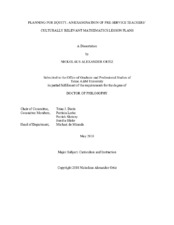| dc.contributor.advisor | Davis, Trina | |
| dc.creator | Ortiz, Nickolaus Alexander | |
| dc.date.accessioned | 2019-01-17T19:39:15Z | |
| dc.date.available | 2020-05-01T06:25:00Z | |
| dc.date.created | 2018-05 | |
| dc.date.issued | 2018-04-27 | |
| dc.date.submitted | May 2018 | |
| dc.identifier.uri | https://hdl.handle.net/1969.1/173588 | |
| dc.description.abstract | This scholarship is based on research conducted by members of the Knowledge for Algebra Teaching for Equity (KATE) Project, a 5-year National Science Foundation (NSF) funded grant that employed strategies in the context of a mathematics problem-solving course. The 29 participants included students enrolled in this course who were engaged in practice teaching that was set in a three-dimensional virtual middle-school classroom in Second Life. A central purpose of this study, then, was to determine what areas of culturally relevant pedagogy (CRP) must be addressed in more detail among PSTs. I provide a rubric to assist in the analysis of mathematics problem solving lesson plans for CRP. Further, I look specifically at the PSTs’ rationale for why they felt their lessons were culturally relevant, and justify why I believe the lesson does or does not align with this pedagogy, and more specifically, argue that cultural relevance exists both in the planning and delivery of a mathematics lesson. Two instruments were utilized in this mixed-methods study, the Mathematics Rubric for Implementing Cultural Relevance (M-RICR), and the Diversity Preparedness Response Inventory (DPRI). Each of the 29 lesson plans were deconstructed to discover themes in how successful the PSTs were in implementing culturally relevant tenets into mathematics lessons designed for a virtual environment, as operationalized in the M-RICR, and the content analysis is discussed through the use of descriptive statistics. The DPRI data was useful in determining how the PSTs’ diversity awareness and beliefs towards equity changed. The findings indicated that four themes (i.e., familiarity, age group, for all, and real-life) arose from the content analysis depicting the PSTs’ justification of their lessons as culturally relevant, and that the PSTs did particularly well with indicators within the tenet of academic iii excellence and critical consciousness. Though most of the lesson plans were placed in the superficial category, there were noteworthy trends in how the PSTs implemented individual MRICR indicators. Lastly, the DPRI data showed that diversity awareness and knowledge about teaching algebra for diversity were impacted most profoundly by one of the guest lectures and the presentation of the lesson within Second Life. | en |
| dc.format.mimetype | application/pdf | |
| dc.language.iso | en | |
| dc.subject | culturally relevant pedagogy | en |
| dc.subject | mathematics | en |
| dc.title | Planning for Equity: An Examination of Pre-Service Teachers' Culturally Relevant Mathematics Lesson Plans | en |
| dc.type | Thesis | en |
| thesis.degree.department | Teaching, Learning, and Culture | en |
| thesis.degree.discipline | Curriculum and Instruction | en |
| thesis.degree.grantor | Texas A & M University | en |
| thesis.degree.name | Doctor of Philosophy | en |
| thesis.degree.level | Doctoral | en |
| dc.contributor.committeeMember | Larke, Patricia | |
| dc.contributor.committeeMember | Slattery, Patrick | |
| dc.contributor.committeeMember | Blake, Jamilia | |
| dc.type.material | text | en |
| dc.date.updated | 2019-01-17T19:39:16Z | |
| local.embargo.terms | 2020-05-01 | |
| local.etdauthor.orcid | 0000-0003-3473-5534 | |


